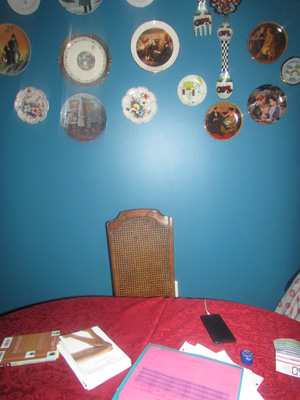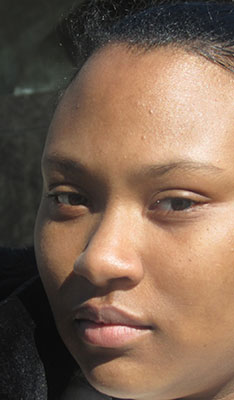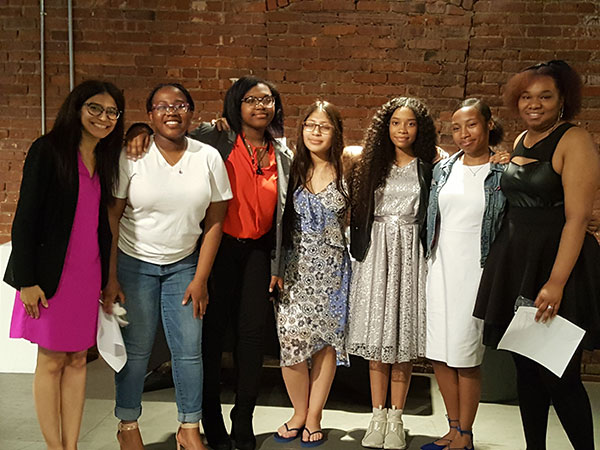Photojournalism Project, Opening Night May 31, 2018
at the Melville Gallery, South Street Seaport Museum, NYC
Good evening. Welcome to the Melville Gallery and this exhibition showcasing the photojournalism project created by students at the Urban Assembly School of Business for Young Women. I am very glad I had the opportunity to teach this class and I respect the desire of these students to see new meaning in things, a desire which grew over the weeks and months and took the form of the work you see here tonight. I am looking forward to telling you about what they learned about photojournalism, and about my basis for teaching it—the great, kind education Aesthetic Realism. But first I want to thank the people who made this project possible:
Field trip at the Battery/Photo: Chelsea Rose
The Urban Assembly School of Business for Young Women, under the guidance of its founding Principal, Patricia Minaya-Orsini, worked in conjunction with the South Street Seaport Museum which received a grant from the New York City Department of Cultural Affairs' Cultural After School Adventures Program.
The project brought together the study of women in New York history and the work they did and relating them to women working in similar fields today. I want to personally thank Yvonne Simons, Deputy Executive Director of the South Street Seaport Museum; Jonathan Anderson, Manager of Education and Family Programs at the Museum; and art teachers and museum educators, Callison Stratton and Chelsea Rose-Pulitzer. Kaitlyn Evans, English Language Arts teacher at the high school participated in every class and her assistance was indispensable.
I am grateful that for over 40 years my approach to photography has been based on this ground-breaking principle stated by Eli Siegel, poet, educator, and founder of Aesthetic Realism:
All beauty is a making one of opposites, and the making one of opposites is what we are going after in ourselves.
Photo: Alyssa Baez
A good photograph, I learned, puts together opposites—such as dark and light, sameness and difference, the everyday and surprising—and we are hoping to make sense of these same opposites in ourselves. For example, throughout the gallery are photographs taken by these young New Yorkers expressing their vision of what makes this such a lively, complex, and often beautiful city. Among them you will find a photograph depicting something so everyday: a man walking on a city street. It is daytime, and a tall sign-post casts an energetic shadow that suggests a human form on the building behind the man, and surprisingly, the shadow seems to follow him. We also see part of a green bicycle pointed in the opposite direction, and it too has a lively form. The man is in a friendly, mysterious relation to what is around him, and the effect is both everyday and definitely surprising.
It is for this reason, among others, that photography is so immensely popular: it can encourage us to see the everyday as surprising, even wonderful, without kidding ourselves. A good photograph counters the all too common feeling that we’ve “seen it all before.” And just the act of trying to see meaning in something, whether it results in a successful photograph or not, is a source of pride and self-respect. We are taking a stand against the feeling other people and things aren’t worthy of our interest. And this feeling, I learned, is contempt, the biggest interference with art and self-respect, which I’ll say more about later.
On the wall behind you is the history and interview project. Students were assigned to research and write about an occupation in which New York City women of the past were active. Then the past was related to the present as each student interviewed and photographed a New York City woman of today working in a similar occupation.
We discussed how an interviewer has to listen with a real desire to know and understand another person. I demonstrated a common and hurtful trick used sometimes not only by interviewers, but in social life, to feign interest. I asked a student to talk to me about herself and as she did I nodded my head occasionally and said “Hmmm.” After they were done laughing, they said this would never fool anyone. But when asked if they themselves enjoyed listening, no one could answer yes. I reminded them that sometimes I had to be critical of them for not listening to each other in our discussions, and I spoke about the difficulties I once had with listening. Often, I said, my attention would wander. In fact, there was a time when the only thing I could remember from conversations was what I had said. When another person was speaking I would wait for the slightest pause, so I could jump in with what I wanted to say, which was after all, much more important, as I conceitedly saw it. No person, I told them, ever respected themselves for not being interested in the thoughts and feelings of others, and I was no exception. I was so glad to relay some of the questions I was asked as a young man in Aesthetic Realism consultations with The Kindest Art, questions that I studied and made it possible for me to like myself for how I listened to other people. For example
- Do you think the feelings of others are as real as your own?
- Do you put limits on how much you want to know people?
- Do you think their thoughts and feelings can add to you, make you more of an individual?
It is moving to see how these young women, over the course of this project, have begun listening more carefully to each other.
Feeling at ease in an interview situation, I said, has to do with a question many photographers have when photographing people on the street. It is often put this way: “Why am I so nervous approaching people I don’t know to photograph them?” This nervousness has to do centrally with how we see other people. An invaluable and necessary question for us to ask is, “What do I have in common with other people, including someone I may want to photograph or interview?” If we see ourselves as too different from other people we will feel anxious around them. The more you see how you are the same and different from another person you will feel more at ease and have more feeling about them.
Photo: Melina Jimenez
The students had been learning in these classes that what we are related to and care for says something about who we are. And so, along with the portraits they made of the women they interviewed, they also took photographs of tools they used in their work, for example the chisels used by a wood-carver, handed down to her by her first teacher.
It is the oneness of opposites, Eli Siegel explained, that makes for beauty, and no opposites are more central in portraiture than surface and depth. We studied this in classes through looking at some of the important portraits and writing of photographers in the history of the medium. The nineteenth century English photographer Julia Margaret Cameron was one of them. She wrote passionately of the famous literary figures and artists who sat for her:
When I have had such men before my camera my whole soul has endeavoured to do its duty towards them, in recording faithfully the greatness of the inner as well as the features of the outer man.
Like every good portrait photographer, she wanted to use surface—“the features of the outer man”—to show their depths. And she felt it was both an honor and an obligation to try to be fair to those depths.
We talked about how different this is from what often takes place in life where what is on the surface—a person’s appearance, how they dress and speak, even the color of their skin—is used to make less of that person and feel superior to them. This is contempt, which Aesthetic Realism vitally explains is the “disposition to think we will be for ourselves by making less of the outside world.” All art, these students are learning, is against this ugly way of seeing people, and encourages our deepest desire, which I also learned from Aesthetic Realism, is “to like the world on an honest or accurate basis.”
As these young women learned about the technical aspects of photography—including shutter speeds, f stops, “cropping,” and point of view—they were in the process of learning how to use a camera to see value in the world. That is a big and beautiful undertaking, and I feel lucky to be in the midst of it myself. I respect them for taking it on, and I hope they continue to look every day for meaning in people and things they can honestly like. It’s so easy to walk down the street and pass things by, not see them with wonder. We speak with others, and too often we don’t give them our full attention or see their feelings as real as our own. And so, we tried to tackle this question in our classes, “What makes us stronger: making fun of things, dismissing them, or seeing them as having wonder and value for us?” It is a question for us all. The purpose of photography is to see things with the fullness of meaning they deserve. When it is taught this way, I have seen, it encourages self-respect, kindness, an increased ability to learn and express ourselves—and the photographs and writing in this exhibition provide beginning evidence for this.
LEN BERNSTEIN
A selection of images from the exhibition
Photo: Erika Davis
Photo: Melina Jimenez
Photo: Zariah Hayes
Photo: Kenisha C. Alston
Photo: Kenisha C. Alston
Photo: Fatima Verdugo
Photo: Alyssa Baez
Photo: Khalima Alston
Photo: Kendolynn Garner
Photo: Alyssa Baez
Photo: Fatima Verdugo
Photo: Erika Davis
Photo: Avianna Pilgrim
Photo: Melina Jimenez
Photo: Kenisha C. Alston
Photojournalism Students & Principal Patricia Minaya on Opening Night/Photo: Alice Bernstein


















